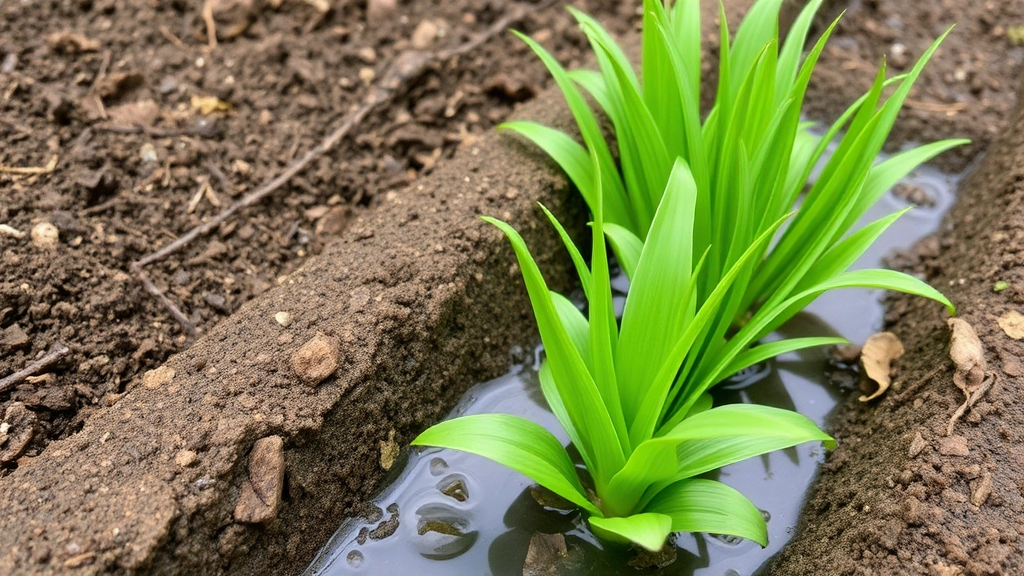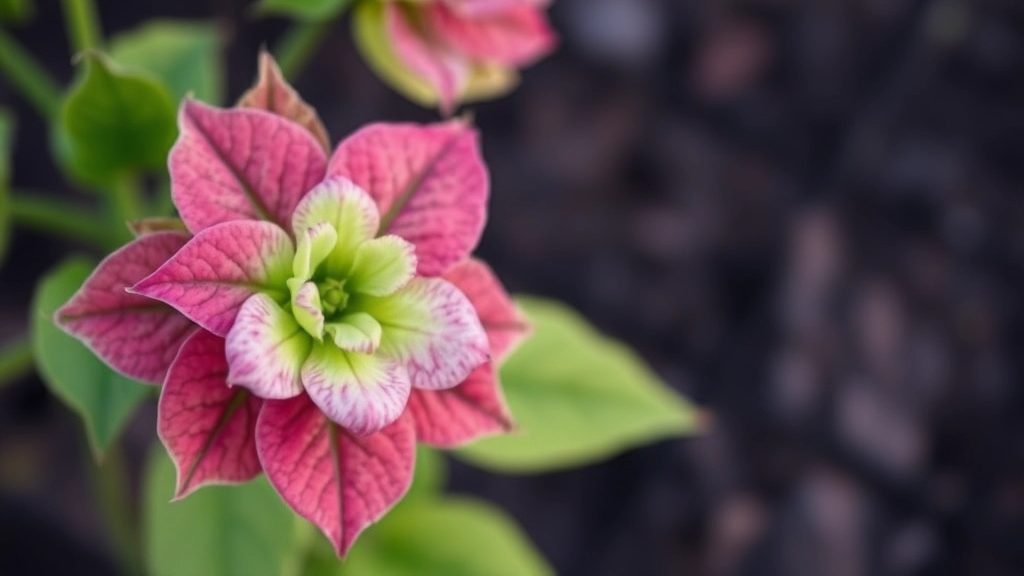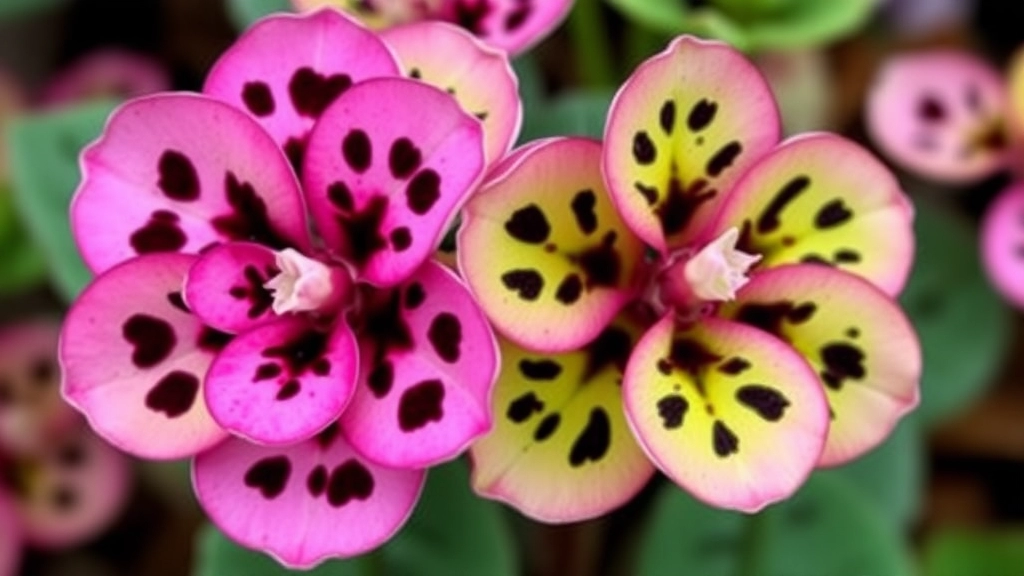Understanding Black Spots on Kalanchoe
Have you noticed black spots on your Kalanchoe? You’re not alone. These pesky spots can be a real eyesore and might even signal underlying issues with your beloved plant. Let’s dive into what causes these black spots and how you can tackle them effectively.
Causes of Black Spots
First off, black spots on Kalanchoe often result from fungal infections or improper watering. Overwatering can lead to root rot, which in turn causes those unsightly black spots. Make sure your plant has good drainage and is not sitting in water. Another culprit could be pests, so keep an eye out for any unwanted visitors.
Tips for Prevention
- Ensure Proper Drainage: Make sure your plant is in a pot with drainage holes.
- Avoid Overwatering: Water only when the top inch of soil is dry.
- Check for Pests: Regularly inspect your plant for any signs of infestation.
By addressing these factors, you can keep your Kalanchoe healthy and spot-free.
Are you noticing unsightly black spots on your Kalanchoe?
This can be a source of concern for any plant enthusiast.
Understanding the common causes of these black spots is crucial for addressing the issue effectively.
### Fungal Infections
One of the primary culprits behind black spots is fungal infections.
These thrive in humid conditions and can spread quickly if not addressed.
#### Signs of Fungal Infections:
– Dark, irregular patches on leaves
– Leaf wilting or dropping
– A powdery or fuzzy appearance on affected areas
If you suspect a fungal infection, timely intervention is key. For more detailed care tips, you might find this [Kalanchoe chocolate soldier care guide](https://planthq.org/chocolate-soldier-kalanchoe-care-guide-tips-for-healthy-growth/) useful.
### Pest Infestations
Another frequent cause of black spots is pest infestations.
Pests like aphids and mealybugs can damage your Kalanchoe, leading to blackened areas on the leaves.
#### Identifying Pests:
– Sticky residue on leaves
– Visible insects on the plant
– Yellowing or curling leaves
Regular inspections can help catch these pests early. You can also explore this [guide on Kalanchoe leaf propagation](https://planthq.org/kalanchoe-leaf-propagation-stepbystep-guide-for-success/) for more insights.
### Overwatering and Poor Drainage
Overwatering is a common mistake that can lead to black spots as well.
When the soil remains soggy, it creates an environment conducive to root rot and fungal growth.
#### Signs of Overwatering:
– Yellowing leaves
– Mushy stems
– Soil that doesn’t dry out between waterings
Ensuring proper drainage is essential for maintaining a healthy Kalanchoe.
Identifying Fungal Infections

So, you’ve noticed some black spots on your Kalanchoe, and you’re wondering if it might be a fungal infection.
It’s a common concern, and it’s crucial to get to the bottom of it quickly.
What to Look For
Fungal infections can manifest in a few distinct ways:
- Black Spots: These usually start small but can spread quickly.
- Wilting Leaves: If your plant looks droopy, it might be a sign of trouble.
- Mouldy Residue: Sometimes, you might see a fuzzy or powdery coating.
If you spot any of these symptoms, it’s time to take action.
Common Fungal Types
Here are a few fungal infections that Kalanchoe might face:
- Leaf Spot: This one’s pretty common. It shows up as dark spots and can spread if not treated.
- Powdery Mildew: Looks like white powder on leaves but can lead to black spots if neglected.
- Root Rot: Often caused by overwatering, it can lead to blackened leaves and a mushy stem.
How to Confirm
- Inspect the Plant: Look closely at the leaves and stems. If the spots are soft, mushy, or spreading, it’s likely a fungal issue.
- Check the Soil: If the soil is consistently wet, root rot could be the culprit.
If you suspect a fungal infection, don’t panic.
Recognizing Pest Infestations
As we delve deeper into the health of your Kalanchoe, it’s vital to consider the impact of pests. Are you noticing unusual black spots that could be a sign of an infestation?
Pest infestations can be sneaky, often manifesting through subtle changes in your plant’s appearance. Here are some common pests to watch for:
- Mealybugs: These small, white, cotton-like pests can cluster on the leaves and stems, sucking the sap and weakening the plant.
- Spider Mites: Tiny and hard to see, they leave fine webbing and can cause stippling on leaves.
- Aphids: Often found on new growth, these green or black insects can distort the leaves and promote the growth of sooty mould.
- Scale Insects: These pests appear as small, brown or white bumps on stems and leaves, robbing your plant of essential nutrients.
Signs to Look For:
- Discoloration: Yellowing or browning leaves can indicate pest damage.
- Sticky Residue: A sticky substance on the leaves may suggest aphid or mealybug presence.
- Webbing: If you notice fine webs, spider mites are likely the culprits.
Prevention Tips:
- Regularly inspect your Kalanchoe for early signs of pests.
- Keep the plant clean by wiping leaves with a damp cloth.
- Ensure good airflow around your plants to deter pests.
Understanding these signs is crucial for maintaining the health of your Kalanchoe. For more detailed guidance on keeping your plants healthy, check out our Guide to Caring for Kalanchoe House Plants in the UK. Additionally, if you have pets, it’s essential to know whether your plants are safe for them. Learn more in our article about Kalanchoe Toxicity to Cats.
Effects of Overwatering and Poor Drainage

Have you noticed black spots on your Kalanchoe and wondered if overwatering could be the culprit?
Overwatering is one of the most common issues faced by plant enthusiasts, and it can lead to significant problems for your Kalanchoe.
When plants receive too much water, their roots can become waterlogged. This creates an environment where harmful pathogens thrive, resulting in black spots on leaves.
Here are some key effects of overwatering and poor drainage:
- Root Rot: Excess moisture can lead to root rot, a condition where roots begin to decay. This can severely affect the plant’s health.
- Fungal Growth: Overly damp conditions are perfect for fungi. Black spots may indicate a fungal infection that has developed due to excessive moisture.
- Nutrient Deficiency: Waterlogged soil can prevent roots from absorbing essential nutrients, leading to further stress and visible symptoms like black spots.
To mitigate these issues, ensure that your Kalanchoe is planted in well-draining soil and that the pot has adequate drainage holes.
Additionally, consider the following tips to maintain proper watering practices:
- Check Soil Moisture: Use your finger to feel the soil. If the top inch is dry, it’s time to water.
- Water Sparingly: Kalanchoe prefers to dry out between waterings. Less is often more.
- Use a Pot with Drainage: Always choose pots that allow excess water to escape.
Preventative Measures for Healthy Kalanchoe
As we delve into the importance of maintaining your Kalanchoe, it’s essential to consider how proactive measures can prevent the onset of black spots.
Key Preventative Strategies
- Optimal Lighting Conditions
- Kalanchoe thrives in bright, indirect sunlight.
- Ensure they receive around six hours of light daily to promote healthy growth.
- Proper Watering Practices
- Water only when the top inch of soil feels dry.
- Avoid letting the plant sit in water to prevent root rot.
- Well-Draining Soil
- Use a cactus or succulent mix for excellent drainage.
- Consider adding perlite or sand to enhance aeration.
- Humidity Control
- Kalanchoe prefers low humidity.
- Keep them in a well-ventilated area to reduce fungal risks.
- Regular Inspections
- Routinely check for signs of pests or disease.
- Early detection can save your plant from severe damage.
- Fertilization
- Feed your Kalanchoe with a balanced, diluted liquid fertiliser during the growing season.
- Avoid over-fertilisation, which can stress the plant.
- Cleanliness
- Wipe leaves regularly to remove dust and prevent fungal growth.
- Ensure pots and tools are clean to avoid introducing pathogens.
Implementing these measures not only keeps your Kalanchoe healthy but also enhances its overall beauty. For more detailed guidance, you might find the complete guide on how to treat black spots on Kalanchoe very useful. Additionally, understanding the essential Kalanchoe care tips for summer success can further ensure your plant thrives throughout the year.
Treatment Options for Affected Plants

So, you’ve spotted those pesky black spots on your Kalanchoe, and you’re probably wondering, “What now?” Don’t worry; we’ve got some straightforward treatment options to help your plant bounce back.
1. Fungal Infections
- Remove Affected Leaves: If you see black spots, start by pruning away the affected leaves. This helps stop the spread.
- Fungicide Application: Consider using a suitable fungicide. Make sure it’s safe for houseplants. Follow the instructions carefully.
- Improve Air Circulation: Place your plant in a spot with better airflow. This helps reduce humidity, making it less inviting for fungi.
2. Pest Infestations
- Inspect Regularly: Check for pests like mealybugs or aphids. If you find them, act fast!
- Insecticidal Soap: Spray with insecticidal soap or neem oil. This is a natural way to tackle pests without harming your plant.
- Isolation: If you have multiple plants, isolate the infested one to prevent spreading.
3. Overwatering and Poor Drainage
- Adjust Watering Schedule: Make sure you’re not watering too often. Kalanchoes prefer to dry out between waterings.
- Check Drainage: Ensure your pot has proper drainage holes. If not, consider repotting into a well-draining mix.
- Soil Amendments: Use cactus or succulent soil that drains quickly to keep those roots healthy.
4. General Care Tips
- Sunlight: Ensure your Kalanchoe is getting enough light. They thrive in bright, indirect sunlight.
- Humidity: Keep humidity levels low. Kalanchoes prefer drier environments.
- Fertilisation: Feed your plant with a balanced, diluted fertiliser during the growing season to boost its health.
Remember, patience is key. It might take some time for your Kalanchoe to recover fully.
Best Practices for Long-Term Care
Maintaining a healthy Kalanchoe is essential to prevent black spots and other issues.
What are the best practices for ensuring your Kalanchoe thrives over time? Here are some key strategies to keep in mind:
1. Optimal Lighting Conditions
- Place your Kalanchoe in bright, indirect sunlight.
- Avoid harsh, direct sunlight to prevent leaf burn.
- Rotate the plant occasionally for even growth.
2. Watering Wisely
- Water only when the top inch of soil feels dry.
- Ensure excess water drains away to prevent root rot.
- Use room temperature water to avoid shocking the plant.
3. Soil Selection
- Choose a well-draining potting mix, preferably one designed for succulents.
- Avoid heavy soils that retain moisture.
4. Regular Inspection
- Check your plant weekly for signs of pests or disease.
- Early detection can save your Kalanchoe from severe damage.
5. Fertilisation
- Feed your Kalanchoe with a balanced, diluted fertiliser during the growing season.
- Limit fertilisation in the dormant winter months.
6. Pruning and Maintenance
- Remove any dead or yellowing leaves promptly.
- Prune to encourage bushier growth and improve air circulation.
7. Repotting When Necessary
- Repot every couple of years or when the plant outgrows its pot.
- This refreshes the soil and provides more space for root growth.
8. Temperature and Humidity Control
- Keep your Kalanchoe in a warm environment, ideally between 15°C to 25°C. For more detailed information, check out the guide on optimal Kalanchoe temperature in Celsius.
- Avoid placing it near drafts or heating vents.
For more tips on maintaining and troubleshooting Kalanchoe health, visit this comprehensive guide on Kalanchoe leaf problems, which covers causes, solutions, and prevention.
FAQs About Black Spots on Kalanchoe
What causes black spots on Kalanchoe leaves?
Black spots on Kalanchoe leaves can be caused by fungal infections, overwatering, poor drainage, or pest infestations. Identifying the root cause is essential for effective treatment.
How can I identify a fungal infection on my Kalanchoe?
Look for small black spots that spread quickly, wilting leaves, or a mouldy residue. These are common signs of a fungal infection.
What types of fungal infections affect Kalanchoe?
Common fungal infections include Leaf Spot, Powdery Mildew, and Root Rot. Each type manifests differently but often leads to black spots on the leaves.
How can I confirm if my Kalanchoe has a fungal infection?
Inspect the plant closely. If the spots are soft, mushy, or spreading, it’s likely a fungal issue. Also, check the soil; consistently wet soil can indicate root rot.
Can overwatering cause black spots on my Kalanchoe?
Yes, overwatering can lead to root rot and fungal growth, both of which can cause black spots on the leaves. Ensure your plant is in well-draining soil and that the pot has adequate drainage holes.
What are the effects of poor drainage on Kalanchoe?
Poor drainage can lead to root rot, fungal growth, and nutrient deficiency, all of which can manifest as black spots on the leaves.
How can I treat black spots caused by fungal infections?
Remove affected leaves, apply a suitable fungicide, and improve air circulation around the plant. These steps can help control and eliminate fungal infections.
What should I do if pests are causing black spots on my Kalanchoe?
Inspect the plant regularly for pests like mealybugs or aphids. Use insecticidal soap or neem oil to treat infestations and isolate the affected plant to prevent spreading.
How can I prevent overwatering my Kalanchoe?
Check soil moisture before watering, water sparingly, and use a pot with drainage holes. Kalanchoe prefers to dry out between waterings.
What general care tips can help prevent black spots on Kalanchoe?
Ensure your Kalanchoe gets enough bright, indirect sunlight, keep humidity levels low, and fertilise with a balanced, diluted fertiliser during the growing season.
How long does it take for a Kalanchoe to recover from black spots?
Recovery time can vary depending on the severity of the issue and the effectiveness of the treatment. Patience is key, as it might take some time for your Kalanchoe to fully recover.
References
-
Kalanchoe Black Spots: How To Identify And Treat Fungal Infections
-
How to Care for Kalanchoe Plants
-
Kalanchoe: How to Grow and Care for Kalanchoe Plants
